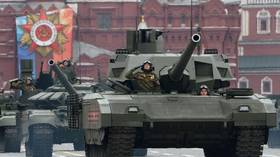Roll on to Red Square! Russia set to showcase next-gen T-14 Armata battle tanks in military parade marking defeat of Nazi Germany

One of the world’s most advanced armored vehicles is on track to be showcased to the public this spring in Moscow as part of Russia's celebrations honoring the Soviet Union’s victory in WWII, its manufacturers have confirmed.
In a statement published on Thursday, the Ural Wagon Factory, which manufactures the T-14 Armata main battle tank, confirmed its crews were heading to the capital to take part in the military procession.
It is apparent that those charged with driving and maintaining the 55-ton weapon of war take their roles seriously.
“The Victory Parade is a special event for us: It’s about honor and responsibility,” said Sergey Stolyarov, the leader of the delegation from the state-run company. “Our tanks are among the best in the world, and we must present them with dignity at an event of this magnitude.”
Held on 9 May each year in the heart of the Russian capital Red Square, the parade commemorates Victory Day, which marks the surrender of Nazi Germany in 1945 shortly after Red Army troops captured Berlin.
Also on rt.com ‘World’s best tank’: Russian troops can look forward to 1st deliveries of ‘revolutionary’ T-14 Armata next year, developer saysWith 14 wheels and an estimated top speed of up to 90 kilometers an hour, the T-14 is based on a modular combat system called Armata, which is also being used to power lighter infantry fighting vehicles and an armored personnel carrier variant.
Inside, a crew of three spots targets, drives the tank and operates its main cannon, which can fire both shells and laser-guided missiles. It has a digital interface, 360-degree ultraviolet HD surveillance cameras, and connects to a global satellite navigation system. The T-14 also boasts an unmanned turret fed by an automatic loading system. Its armaments underwent field testing in Syria.
Russia’s Armed Forces were reportedly planning to take delivery of hundreds of T-14s by the end of 2020, but shipments were delayed due to high costs and the technical complexity associated with manufacturing. However, last week Defense Minister Sergei Shoigu announced that the army would receive a pilot batch of the tanks next year.
Like almost all of Russia’s military hardware, the tank was designed, developed and manufactured in Russia by a state-owned firm. However, some analysts say it actually draws more inspiration from Western competitors than its Soviet-era predecessors.
Writing in Russia’s Military Industrial Courier, experts Oleg Falichev and Petr Cherkashin argued that “the T-14 Armata tank is very close in many respects to the appearance of the joint development tank of West Germany and the USA of the 1970s.”
Also on rt.com From strategic bombers to combat robots: What Russian weapons to look out for in 2021However, in a showdown between the Russian-made vehicle and the closest American equivalent, the M1 Abrams, analysts warn a head-to-head skirmish could be too close to call. Washington-based international affairs magazine The National Interest noted the T-14’s “decent defenses” against US-made TOW missiles, but said judgement would have to be reserved on how well they work.
“As is always the case in matchmaking, you can theorize all you want, but only a real close encounter will reveal the truth,” the journal argued. “Let us hope, then, that never the twain shall meet.”
Think your friends would be interested? Share this story!













